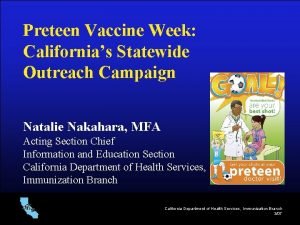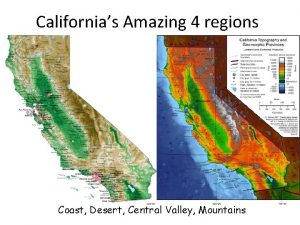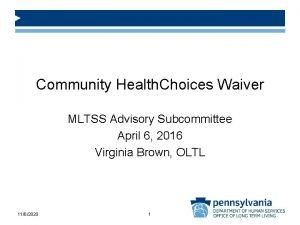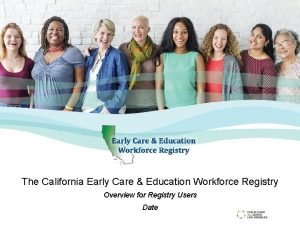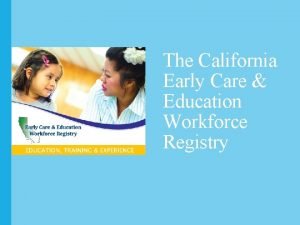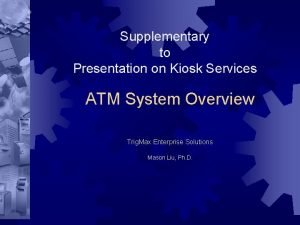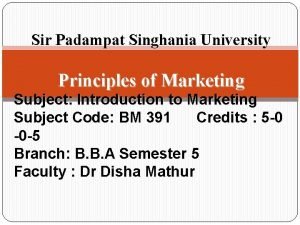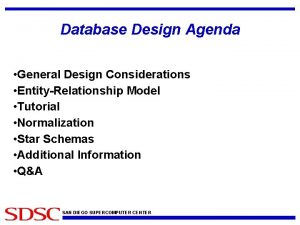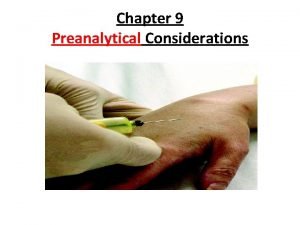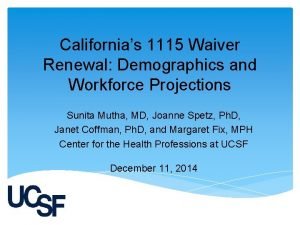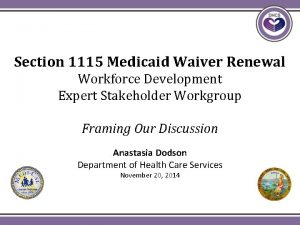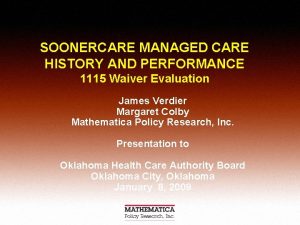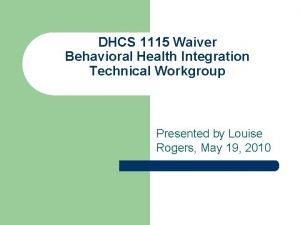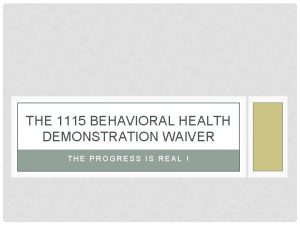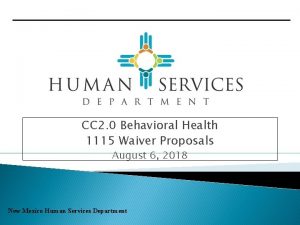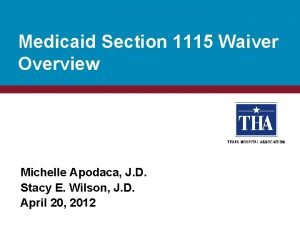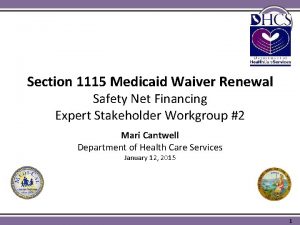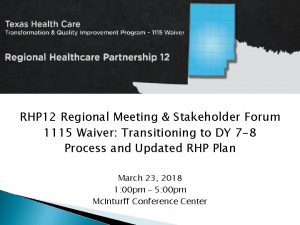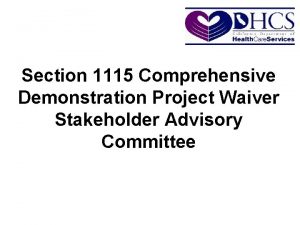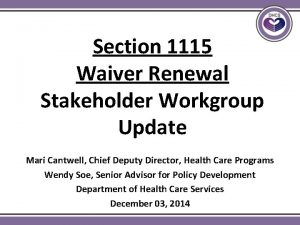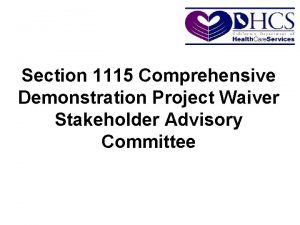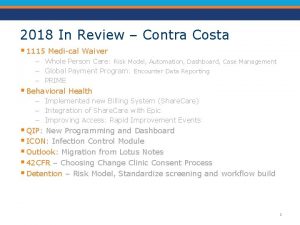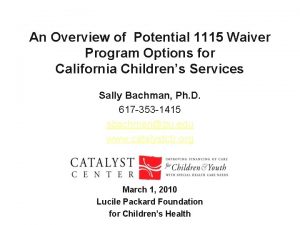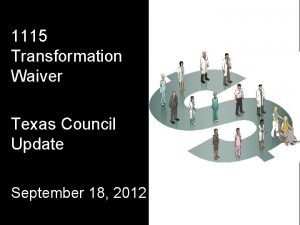Health Care Workforce Considerations for Californias 1115 Waiver



















- Slides: 19

Health Care Workforce Considerations for California’s 1115 Waiver Renewal Sunita Mutha, MD, Joanne Spetz, Ph. D, Janet Coffman, Ph. D, and Margaret Fix, MPH Center for the Health Professions at UCSF November 20, 2014

Center for the Health Professions We are the leading source for research insights into the evolving health care workforce and for pioneering training programs that empower leaders to navigate change Expertise across all health professions Workforce policy is a tool to drive delivery system change

Overview of Workforce Issues Many Medi-Cal beneficiaries have complex conditions and provider needs Many ways to measure provider participation and availability Provider distribution varies by geography and by provider type Diversity does not mirror population High debt burden Long pipeline for some professions Educational programs may not yield needed competencies Need new workforce roles to match needs Medi-Cal beneficiaries may have difficulty accessing some types of professionals

Selected Data

Regional Variation in MDs Providing Care per 100, 000 in 2013 258 174 206 146 125 149 201 202 204 121 Ba y C Ar e ea C nt en ra l. C tra oa l. V st al le y/ In Si la e. nd. . Em Lo pi re s An ge le N s or th Va Nor th lle y/ Si er ra O ra ng So Sa e ut n h D ie Va go lle y/ Si er ra 300 250 200 150 100 50 0 Source: Medical Board of California Mandatory Survey and California Department of Finance Demographic Unit. Includes only MDs who have completed training and provide at least 20 hours of patient care per week.

Nurse Practitioners per 100, 000 in 2008 Source: Bates, Blash, Chapman, & Dower, 2011

California Physicians Accepting New Patients By Payer, 2013 Private Insurance 79%75% Medicare Medi-Cal 80% 79% 76% 62% 66% 57% 64% 47% 44% All Physicians Uninsured 39% PCPs Non-PCPs Source: Coffman, et al. Physician Participation in Medi-Cal. 2014.

California NPs Accepting New Patients By Payer, 2010 Private Insurance 97% Medicare 97% Medi-Cal 94% Uninsured 98% NPs Source: Spetz, et al. 2010 Survey of Nurse Practitioners and Certified Nurse Midwives, 2011.

Primary Care Physicians Accepting New Medi-Cal Patients by Region Source: Coffman, et al. Physician Participation in Medi-Cal. 2014.

Non-Primary Care Physicians Accepting New Medi-Cal Patients by Region Source: Coffman, et al. Physician Participation in Medi-Cal. 2014.

Psychologists per 100, 000 in 2008 Source: Bates, Blash, Chapman, & Dower, 2011

Marriage and Family Therapists per 100, 000 in 2008 Source: Bates, Blash, Chapman, & Dower, 2011

3 Proposed Workforce Goals 1. Increase # in medically underserved areas or who serve a high number of Medicaid beneficiaries a) Train new health professionals b) Increase retention c) Explore practice limitations d) Work with greater efficiency 2. Develop innovative ways to address whole person care to meet physical and mental health needs 3. Create incentives to encourage greater commitment to serve Medicaid beneficiaries and practice in underserved areas

Goal 1 a: Train New Professionals Strategy Example Train and attract more new health professionals (HP), emphasis on: Train in professions and specialties of greatest need Train in settings with high % of Medicaid beneficiaries Train those most likely to serve Medicaid beneficiaries after completing training Song-Brown grants State-based Medicaid graduate medical education (GME) for primary care in FQHCs Scholarships (e. g. , Health Professions Education Foundation programs) Cal. SEARCH grants Mental Health Services Act (MHSA) Workforce Education and Training (WET) Program

Goal 1 b: Increase Retention Strategy Example Eliminate or reduce barriers • Loan repayment for HP who for health professionals to care for underserved continue to serve Medicaid populations or practice in beneficiaries underserved areas • Facilitate physician volunteers who offer free or reduced-rate services

Goal 1 c: Explore Practice Limitations Strategy Example • Assess the need to change licensure/certification, including expansion of scope • Explore options for employers to permit health professionals to practice at the top of their licenses • Expand scope of practice of existing professionals (i. e. , SB 493) • Community Paramedicine Health Workforce Pilot Project • Establish certification protocol for expanded use of MFTs, PAs, and others • Advanced practice nurses practice as independently as permitted under law

Goal 1 d: Add Greater Efficiency Strategy • Use technology to expand access to preventive, primary, and specialty care • Use new models of care to enable existing health professionals to provide care more efficiently Example • Team-based care • Cross train incumbent workers (e. g. , physical plus behavioral health) • Group visits • Email & other Internet-based care • Telehealth • Training for IHSS workers to more effectively communicate with other care providers

Goal 2: Innovative Ways to Address Whole Person Care Strategy Example • Pilot new categories of service providers such as community health workers, interns, peer support counselors (MH/SUD) • Create new categories of health workers and care givers • Expand access to desired treatment modalities • Coordinate with social, housing, vocational training and other services • MHSA Workforce Education and Training grants • Community health workers • Peer support and family caregivers • IHSS worker training to work with care teams • Train physicians in medication assisted therapy to increase access to needed SUD treatment • Training & coordination with non -health community services

Goal 3: Create Incentives Strategy • Reduce barriers to participation in Medicaid • Provide financial incentives for participation in exchange for a commitment to serve Medicaid beneficiaries Example • Subsidize malpractice insurance • Malpractice relief for physicians who volunteer • Higher payment rates • Reduce administrative burden • Differential payment for IHSS and other workers who complete additional training • Bonus payment pool to Critical Access Hospitals for loan repayment programs
 Grade californias vaccine
Grade californias vaccine Californias natural harbour
Californias natural harbour Ohio home care waiver
Ohio home care waiver Ohio home care waiver conditions of participation
Ohio home care waiver conditions of participation Community health choices waiver
Community health choices waiver Primary secondary tertiary care definition
Primary secondary tertiary care definition Early care and education workforce registry
Early care and education workforce registry California workforce registry
California workforce registry Health and social care values unit 2
Health and social care values unit 2 Health and social care component 3 health and wellbeing
Health and social care component 3 health and wellbeing General consideration in machine design
General consideration in machine design Tax considerations for setting up a new business
Tax considerations for setting up a new business Atm kiosk software
Atm kiosk software Exchange transaction and relationship in marketing
Exchange transaction and relationship in marketing Mechanical considerations of transmission line
Mechanical considerations of transmission line Database design considerations
Database design considerations Contrasting acquisition
Contrasting acquisition Cloud delivery model considerations
Cloud delivery model considerations Writing strategies and ethical considerations
Writing strategies and ethical considerations What is basal state in phlebotomy
What is basal state in phlebotomy
